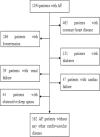Relation of low vitamin D to nonvalvular persistent atrial fibrillation in Chinese patients
- PMID: 24206389
- PMCID: PMC6932220
- DOI: 10.1111/anec.12105
Relation of low vitamin D to nonvalvular persistent atrial fibrillation in Chinese patients
Abstract
Background: Low vitamin D status has been associated with increased risk of cardiovascular disease. Atrial fibrillation (AF) is the most common cardiac arrhythmia. We evaluated the association between low vitamin D and AF.
Methods: We analyzed data from 162 Chinese patients with nonvalvular persistent AF and no other cardiovascular disease whose serum 25-hydroxyvitamin D [25(OH)D] levels were measured in our hospital (AF group). Healthy subjects without AF who underwent health screening at our hospital served as controls (non-AF group, n = 160). 25(OH)D was measured by chemiluminescence assay.
Results: The serum 25(OH)D level was significantly lower in the AF group than in the non-AF group (18.5 ± 10.3 vs 21.4 ± 10.7 ng/mL, P < 0.05). The high-sensitivity C-reactive protein (hsCRP) level was significantly higher in the AF group than in the non-AF group (0.35 ± 0.19 vs 0.2 ± 0.17 mg/dL, P < 0.01). The average left atrial diameter was significantly larger in the AF group than in the non-AF group (P < 0.01). The serum 25(OH)D level showed a negative correlation with left atrial diameter, hsCRP level, and pulmonary artery systolic pressure. Logistic regression analysis identified that 25(OH)D was related to AF. Patients whose vitamin D levels were in the lowest 25(OH)D category (<20 ng/mL) were more often in the AF group, with their incidence about twofold higher than those in the highest 25(OH)D category (>30 ng/mL).
Conclusions: Low vitamin D levels are associated with AF. It may be involved in its development.
Keywords: atrial fibrillation; echocardiography; high-sensitivity C-reactive protein (hsCRP); vitamin D.
©2013 Wiley Periodicals, Inc.
Figures
Comment in
-
Vitamin D Levels in Patients with Atrial Fibrillation.Ann Noninvasive Electrocardiol. 2016 Nov;21(6):622-623. doi: 10.1111/anec.12306. Epub 2016 Jun 20. Ann Noninvasive Electrocardiol. 2016. PMID: 27324922 Free PMC article. No abstract available.
References
-
- Pilz S, Tomaschitz A, Ritz E, et al. Vitamin D status and arterial ypertension: A systematic review. Nat Rev Cardiol 2009;6:621–630. - PubMed
-
- Dobnig H, Pilz S, Scharnagl H, et al. Independent association of low serum 25‐hydroxyvitamin D and 1,25‐dihydroxyvitamin D levels with all cause and cardiovascular mortality. Arch Intern Med 2008;168:1340–1349. - PubMed
MeSH terms
Substances
LinkOut - more resources
Full Text Sources
Other Literature Sources
Medical
Research Materials




